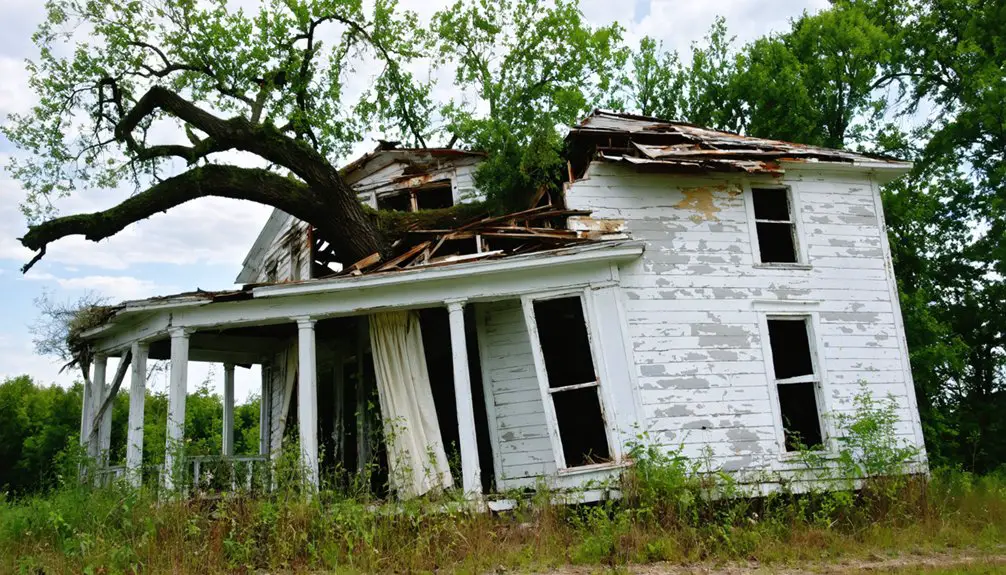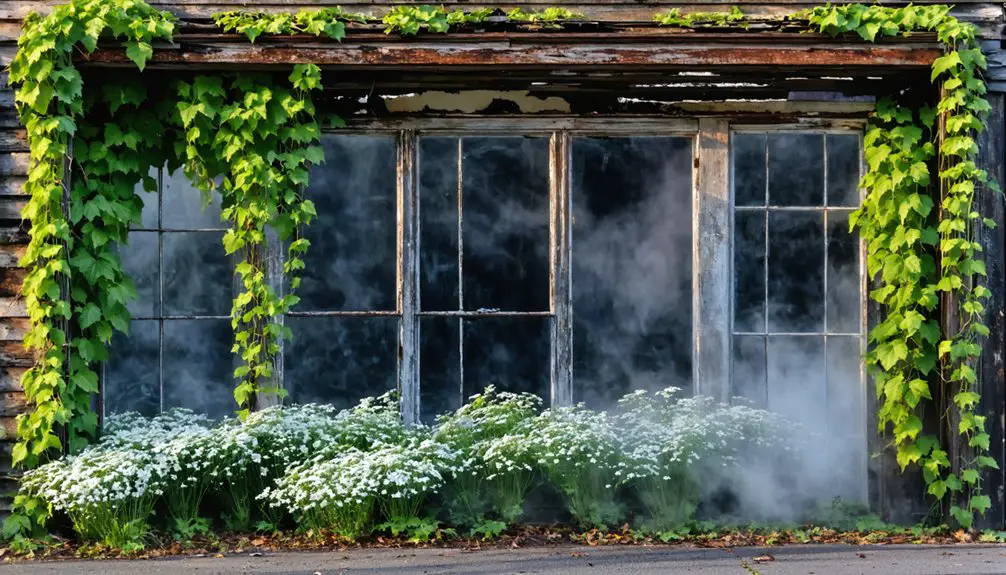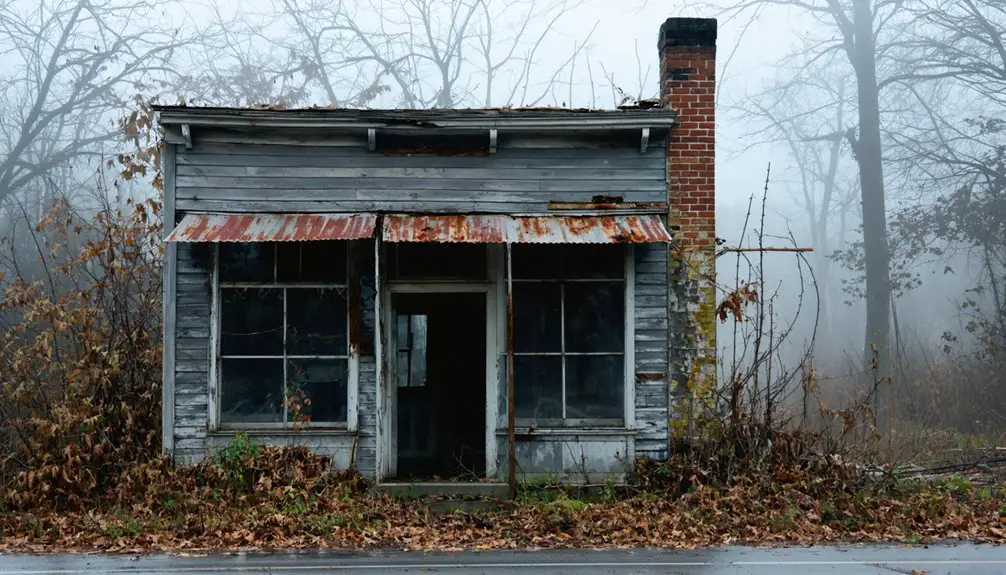You’ll find Berringer Corners nestled in Missaukee County, Michigan, where a once-thriving lumber settlement emerged in the 1880s. Initially established by pioneer families from Virginia, Pennsylvania, and Ohio, the town flourished during Michigan’s logging boom, complete with sawmills, general stores, and railway connections. Today, nature has reclaimed most of the town’s structures, leaving only scattered ruins, foundations, and Pleasant View Cemetery to tell its story of rise and decline.
Key Takeaways
- Berringer Corners developed as a Michigan lumber settlement between Cadillac and Lucas, reaching peak production of over one billion board feet around 1905.
- The town thrived during the 1880s lumber boom under Mr. Bearinger’s leadership, with established businesses, sawmills, and railroad connections.
- Community decline began with urban outmigration, followed by rail service discontinuation, business closures, and eventual abandonment of public buildings.
- Physical remnants include scattered ruins, deteriorating structures, abandoned foundations, and industrial artifacts from its logging-town past.
- Pleasant View Cemetery remains a key historical site, while dense forest has reclaimed most of the former town’s infrastructure.
The Rise of a Lumber Settlement
While Michigan’s vast white pine forests drew numerous logging operations in the late 19th century, Berringer Corners emerged as a notable lumber settlement in Missaukee County, positioned strategically between Cadillac and Lucas.
You’d find the settlement growing from early timber camps, like E. Hall’s operation in Butterfield Township, into a bustling community shaped by innovative lumbering techniques.
Charles L. Dolph established essential infrastructure by building a store and barn, while entrepreneurs like J. Carr and J. Barrett set up sawmills around 1905.
The settlement adapted to seasonal work patterns, with loggers using horse-drawn sleds and “big wheels” in winter, then floating logs downstream during spring thaw.
Company houses, general stores, and barns supported both workers and their families during peak logging periods, achieving production levels that rivaled Saginaw’s historic 1882 peak of over one billion board feet.
Similar to the Snyder House hotel, these settlements provided crucial accommodations for the region’s hardworking lumberjacks during their seasonal operations.
Early Settlers and Community Life
When you look at Berringer Corners in the 1880s, you’ll find pioneer families establishing homesteads along the waterways, building log cabins from lumber cut at nearby mills.
The settlers’ daily routines centered around farming, hunting deer and squirrels for food, and gathering resources like maple sugar from the surrounding wilderness. The rich soil, consisting of black vegetable mould mixed with clay and sand, proved ideal for growing crops. Native Potawatomi tribes who lived in the region before the settlers had practiced seasonal agriculture and hunting in these same fertile lands.
Church services and social gatherings in settlers’ homes formed the heart of community life, bringing families together despite the challenges of frontier living.
Pioneer Families Arrive 1880s
The first pioneer families of Berringer Corners arrived in the 1880s, decades after initial settlement activity had begun in Michigan’s surrounding regions during the 1830s and 1840s. Settler migration patterns followed waterways, particularly along the Grand River, where families established their homesteads after Native American treaties opened the land for purchase.
- Early settlers came primarily from Virginia, Pennsylvania, and Ohio, establishing a mix of farms and trading posts.
- Family legacies began with solo land claims, followed by relatives joining later.
- Most pioneers traveled by ox-team and wagon, bringing essential supplies for frontier life.
- The community grew around shared labor and social gatherings, with Barringer’s house serving as both tavern and meeting place.
You’ll find these families were often first-generation Americans or recent migrants, seeking freedom and opportunity in Michigan’s frontier lands. The early settlers faced significant hardships, with inadequate food supplies being one of their greatest challenges.
Daily Life and Work
Life in Berringer Corners during the 1880s centered around intense physical labor, with settlers dividing their time between subsistence farming and seasonal logging work.
You’d find families tending to corn, wheat, and potato crops while raising livestock for sustenance. Their farming practices included clearing forested land and building fences using basic hand tools and horse-drawn equipment.
The timber industry dominated the local economy, with many settlers working in lumber camps during winter months. Similar to the success of the first copper boom in 1844, logging provided economic opportunities for early settlers.
You’d see men cutting pine and hardwood, hauling logs to sawmills through dirt roads on horse-drawn wagons. Soon after the lumber boom ended, Berringer Corners became one of many abandoned villages in Michigan.
At home, crucial crafts like blacksmithing, carpentry, and food preservation kept the community self-sufficient.
Children pitched in early, learning essential skills while helping with farm chores and logging camp duties, though this often interrupted their formal schooling.
Church and Social Gatherings
Beyond the daily work routines, spiritual and social life in Berringer Corners took root on March 26, 1836, when eight pioneers established the local church society.
These early settlers transformed a log schoolhouse on Battle Creek’s banks into their spiritual home, where they’d gather for worship and fellowship under visiting pastors from Kalamazoo and Allegan. Similar to First Reformed Church in Grand Rapids, the congregation initially met in a schoolhouse before establishing a permanent building. Like many congregations of that era such as the Nardin Park Methodist, the community would grow from humble beginnings into a thriving fellowship.
The church quickly became central to community cohesion through:
- Regular Saturday and Sunday gatherings that provided essential social connections
- Sunday School programs led by Moses Hall Jr. until 1860
- Multi-purpose use of the building for both religious and social functions
- Traditional services featuring scripture readings and hymn singing
Under Tolman Hall’s 50-year secretarial guidance and following Presbyterian-Congregational traditions, church gatherings helped structure frontier life while reinforcing shared values among settlers.
Economic Growth and Peak Years
During Michigan’s lumber boom of the late 1880s, Berringer Corners emerged as a bustling economic hub centered around its thriving timber operations.
The lumber industry’s economic impact transformed this northeastern Michigan settlement, with prominent figures like Mr. Bearinger leading extensive logging enterprises throughout the region. You’ll find that this period of prosperity led to the strategic formation of Bearinger Township, primarily to reduce taxation on these lucrative operations.
Bearinger Township emerged as a calculated response to Michigan’s lumber boom, designed to minimize taxation on profitable logging operations.
The Michigan Central Railroad‘s expansion provided essential transportation links, enabling timber shipments to distant markets. Similar to Glendora’s infrastructure, the town maintained a 1,660-foot passing siding for efficient rail operations.
You could’ve found a variety of supporting businesses catering to lumber workers and their families, including general stores and blacksmith shops.
While specific population numbers remain scarce, the town’s growth mirrored other successful lumber communities in Michigan’s Upper Peninsula during this era.
Signs of Decline and Abandonment

As the lumber industry waned in the early 1900s, Berringer Corners experienced a swift and irreversible decline. The town’s urban outmigration patterns revealed a stark exodus as younger residents fled to larger cities for work.
You’ll find evidence of community fragmentation effects in the abandoned buildings and overgrown streets that once buzzed with activity.
- Mine closures triggered a domino effect of business failures, leaving empty storefronts and hotels.
- Rail service discontinuation cut off essential transportation links.
- Public buildings, including schools and the post office, shut down as population dwindled.
- Natural reclamation took hold as wildlife returned to former residential areas.
Today, you’ll see stone foundations peeking through thick vegetation, while rust and weather slowly claim the remaining structures, proof of a once-thriving community’s dissolution.
Notable Structures and Remnants
The ghostly remnants of Berringer Corners tell their story through scattered ruins and deteriorating structures across the former townsite.
Time-worn ruins and crumbling structures echo silent stories across the abandoned landscape of what was once Berringer Corners.
You’ll find abandoned foundations of homes and businesses, with stone and brick walls partially standing as silent witnesses to the past. Throughout the area, cellar holes and basement remains mark where buildings once stood.
Industrial remnants hint at the town’s economic life, including traces of what might’ve been sawmills or loading docks.
You’ll discover scattered artifacts like rusted machinery parts and metal tools. The site of at least one church is marked by stone foundations, while nearby cemeteries hold weathered tombstones.
As you explore, you’ll spot old roadbeds, bridge remains, and everyday items like broken pottery and glass – each piece offering a glimpse into Berringer Corners’ forgotten past.
Natural Reclamation of the Town

If you visit Berringer Corners today, you’ll find dense forest growth consuming the town’s remnants, with saplings and underbrush pushing through old foundations and along forgotten roadbeds.
Nature’s seasonal rhythms continually reshape the ruins through freeze-thaw cycles, while spring and summer vegetation explosively reclaims more territory each year.
The site now serves as a thriving wildlife corridor, where birds nest in crumbling structures and small mammals make homes among the decaying remnants of this once-active settlement.
Forest Growth Takes Over
Natural reclamation transformed Berringer Corners into a thriving forest ecosystem over several decades, as native trees like oak, maple, and pine gradually overtook the abandoned settlement.
The forest dynamics showcase nature’s resilience, with early successional plants giving way to mature woodland communities. You’ll find evidence of ecological restoration throughout the former town site, where vegetation now masks the remnants of human habitation.
- Tree roots have penetrated building foundations, accelerating structural decay
- Dense canopy cover creates shaded conditions perfect for understory growth
- Wildlife populations have shifted from open-habitat to forest-dependent species
- Soil composition has evolved from disturbed to nutrient-rich forest substrates
Today, only subtle depressions and faint traces of old roadbeds hint at Berringer Corners’ existence beneath the forest cover.
Seasonal Changes Shape Ruins
Seasonal cycles of weather steadily reshape Berringer Corners’ remaining structures through an endless interplay of destructive forces.
You’ll see how spring thaws saturate the foundations, while summer heat warps the weathered wood of old storefronts.
During autumn, fallen leaves clog drainage paths, trapping moisture that freezes and expands in winter, shattering brick and stone.
The forces of seasonal erosion intensify as rain-soaked soil shifts beneath century-old walls.
Wildlife interactions leave their mark too – from birds nesting in eaves to small mammals burrowing into weakened foundations.
You’ll notice how nature’s rhythm transforms these ruins throughout the year, as each season brings its own form of decay.
Snow blankets the town in winter, only to fuel damaging spring floods when it melts.
Wildlife Reclaims Settlement Spaces
Beyond the crumbling walls lies another chapter in Berringer Corners’ evolution, as wildlife steadily reclaims the abandoned settlement.
You’ll find diverse wildlife habitats emerging throughout the ghost town’s remnants, where nature’s resilience shines through the decay. The absence of human activity has restored ecological balance, transforming the once-bustling community into a thriving wilderness sanctuary.
- Raccoons and foxes now den in collapsed cellars and abandoned barns.
- Owls nest in the old church’s bell tower, hunting rodents in former gardens.
- Native vegetation infiltrates building foundations, creating shelter for small mammals.
- Natural springs, once diverted for town use, now support amphibian breeding pools.
The town’s structures serve as the framework for this remarkable transformation, where each passing season brings new species establishing their domains.
Historical Significance in Michigan
The remnants of Berringer Corners stand as a tribute to Michigan’s booming industrial era of the late 1800s, when natural resource extraction shaped the state’s development.
You’ll find its story echoes countless other Michigan ghost towns, where immigrant workers flocked to mining and logging operations seeking prosperity in the region’s rich natural resources.
Like many sites targeted for ghost town tourism and historical preservation today, Berringer Corners represents the dramatic economic cycles that transformed Michigan’s landscape.
The settlement’s rise and fall mirrors the broader pattern of boom-and-bust development throughout the state, where communities emerged rapidly around mines and timber operations, only to vanish when resources were depleted.
These abandoned settlements now serve as crucial reminders of Michigan’s industrial heritage and the immigrant communities that built the state’s early economy.
Ghost Town Research and Documentation
Modern research at Berringer Corners combines traditional archaeological methods with cutting-edge documentation techniques to uncover its past.
Innovative archaeological approaches blend with modern technology to reveal hidden stories within Michigan’s historic Berringer Corners settlement.
Ghost town preservation efforts include careful site mapping and collaboration with local historical societies to protect remaining structures while enabling thorough investigation.
Here’s what you’ll find in current documentation practices:
- Non-invasive survey methods using humidity meters and video equipment to assess site conditions
- Paranormal documentation through ITC tools and specialized cameras for extensive site analysis
- Detailed GPS mapping and photographic records maintained by research teams
- Oral history collection from local community members to supplement physical evidence
You’re encouraged to participate in research through approved historical society programs, which help maintain site integrity while advancing our understanding of Michigan’s ghost town heritage.
Exploring Present-Day Berringer Corners
Visiting present-day Berringer Corners reveals a quiet rural landscape in Monroe County, Michigan, where farmland and small forest patches dominate the terrain.
You’ll find no traditional town center or commercial district, as this ghost town‘s presence is marked mainly through local historical references and cemetery records.
When exploring Berringer Corners’ geography, you’ll encounter flat to gently rolling land typical of southern Michigan, accessed by rural roads that connect to larger county highways.
Berringer Corners’ demographics reflect its ghost town status – there’s no centralized population, just scattered rural residences.
You won’t find this location on standard maps, but you can discover its legacy through Pleasant View Cemetery and local historical documents that preserve its memory.
Frequently Asked Questions
Are There Any Paranormal or Supernatural Stories Associated With Berringer Corners?
You won’t find documented ghostly encounters or urban legends here – historical records and local sources don’t mention any supernatural activity, unlike other Michigan ghost towns that preserve tales of paranormal occurrences.
What Happened to the Residents’ Personal Belongings When They Left?
You’ll find that most abandoned possessions were sold, relocated, or salvaged when residents left. What couldn’t be moved likely deteriorated over time, leaving few items of historical significance behind.
Is Metal Detecting or Artifact Collection Allowed at Berringer Corners?
You can’t just grab a metal detector and start digging – there’s no explicit information about metal detecting regulations or artifact preservation policies for Berringer Corners. You’ll need proper permissions first.
How Safe Is It to Visit Berringer Corners During Winter?
You’ll need extreme winter precautions when visiting during cold months. Check travel advisories, bring emergency supplies, and don’t explore alone. Ice and snow create dangerous conditions in remote areas.
Were There Any Famous People or Notable Events Linked to Berringer Corners?
Drawing a blank here – historical records don’t show any famous residents or notable events in your search. You won’t find any standout figures or memorable happenings from this settlement.
References
- https://www.youtube.com/watch?v=7-vjuqiGWJU
- https://99wfmk.com/michigan-ghost-town-gallery/
- https://bearingertownship.org/about-us/
- https://mtu-vpol.github.io/ghosttowns/
- https://99wfmk.com/glendora-hills-corners/
- https://koster.typepad.com/files/earlyhistoryofmissaukeereaderfinal.pdf
- https://mff.forest.mtu.edu/PDF/1-TreeBasics/3-History.pdf
- https://www.saginaw-mi.com/222/Saginaw-History
- https://www.saintignace.org/tidbits-of-history/
- https://migenweb.org/berrien/history.htm



